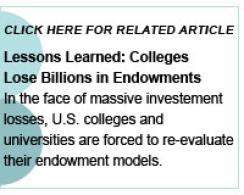Wake Forest may have generated returns that were among the best in the endowment world over the last decade, but the university thinks it’s time to rein in risk and reevaluate its asset allocation. Though it escaped some of the damage from the credit crisis — the portfolio is down 20.5 percent as of June, 2009 — and did not face the liquidity problems confronted by many of its endowment brethren, Wake Forest is now switching gears and has brought in an outsider to the endowment world to add guard rails to the portfolio, evaluating risk, portfolio construction and asset allocation afresh.
James Dunn is steeped in risk management, due diligence and portfolio theory. He was CIO of Wilshire Funds Management, the asset management arm of Wilshire Associates that manages about $52 billion, before moving from the West Coast to North Carolina in July of this year to take the Wake Forest post. He is now assessing the endowment fund in light of the huge losses incurred by universities and other investors in 2008.

Dunn, like Morrell, also is taking a seat in the cabinet of the university. This way he’ll have an insider’s view of what programs and capital improvements the university needs to fund and a seat overseeing the endowment. It’s a trend that is playing out at other colleges and universities as school officials look back at the chaos of the credit crisis, liquidity and the proportion of their operating budgets funded by their endowments’ earnings and whether that is sustainable.
Dunn says the administration of universities themselves and the overseers of endowments need to communicate more swiftly and more comprehensively. “The university has a master plan to be aggressive in recruiting students, adding a new recreation center, rehabbing buildings, and relying on the endowment is a big part of that.” Wake Forest’s endowment contributes about 10 percent of operating funds for the university, a level that Dunn says served it well during 2008 and is on the low end compared to other schools.
The tactical pool was a unique innovation for the school. It was up more than 36 percent year-to-date as of November, but was down about 32 percent last year. Dunn says Morrell has the freedom to make investments anywhere in the market and often used exchange-traded funds and other mutual funds to gain exposure to different sectors. Morrell will continue running the tactical portfolio. Dunn says the sub-fund also gave the university flexibility during the crisis when it came to liquidity because of its stakes in easily traded mutual funds, even though Wake Forest only modestly tapped the pool for cash needs. Commenting on the strategy of the tactical portfolio, Dunn says, “We don’t just sit back and let the asset allocation do its magic.” He adds, “Asset allocation is not a spectator sport.”
The endowment, which has an approximate 40 percent stake in alternatives, including hedge funds, real estate and private equity, escaped much of the damage because of liquidity it had in the tactical pool and, Dunn says, “we don’t have a whole lot of unfunded commitments to private equity.” Unfunded commitments, future obligations to private funds, were one of the issues that tripped up other institutions as they scrambled to make these payments in the credit crisis despite a complete shutdown in capital distributions. In better economic times, it was a virtuous cycle: distributions from private equity pools funded capital commitments.
Dunn says he is now repositioning the endowment portfolio to invest more in fixed income, including distressed opportunities and corporate debt. In addition, he is implementing hedging techniques such as putting collars around certain positions to lock in gains and protect the downside. He is also evaluating the spending model, by putting money away in fat years to use as a buffer in leaner years and establishing an asset/liability framework. “You see liability matching all the time in pension funds, but it’s been overlooked in the endowment world.”
Wake Forest is still stinging from losing $200 million in fiscal 2009. “That’s a serious loss.” Now, everybody is practicing asset protection. “When you’re on a cruise ship, you do life boat drills. In a crisis, we know what we will cut, what capital calls we won’t be able to meet. There should be no surprises,” says Dunn.







